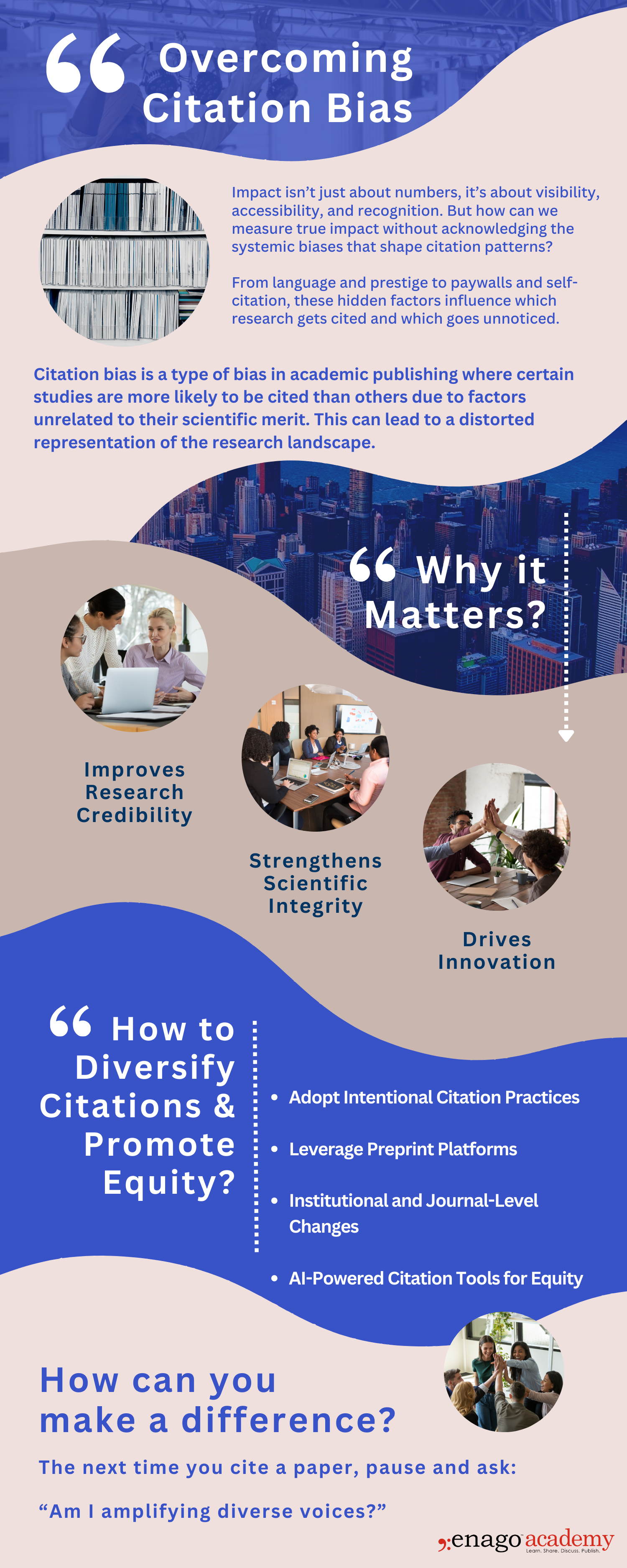Who Gets Cited? Restoring Missing Voices in Academic Research

Citation bias, prevalent across scientific disciplines, leads to unequal recognition of diverse voices. This bias can occur in key sections of research articles, such as the Introduction, where the study’s importance is justified, and the Discussion, where findings are contextualized. It occurs when authors selectively cite studies that align with their conclusions or preconceived notions. This article delves into the underlying factors driving this disparity, its impact on academic equity, and practical strategies to foster a more inclusive and fairer scholarly ecosystem
The concept of citation bias has been recognized across various fields, with its earliest recorded mention in physics in 1985, highlighting a bias against Eastern bloc particle accelerators. Over the past four decades, a significant disparity has been observed in citation patterns across different racial and ethnic groups in the scientific community. Research indicates that African American and Hispanic scientists are cited less frequently than expected, while Asian Pacific Islander (API) and White scientists are often cited more than expected. This phenomenon is not limited to specific fields but persists across a wide range of disciplines, including biomedical, behavioral, and ecological sciences; engineering and computational sciences; physical and mathematical sciences; as well as social sciences.
This persistent disparity highlights a systemic issue that affects the visibility and recognition of scientific contributions from diverse backgrounds. It raises a crucial question: Why are diverse voices missing in citation networks, and how can we change this?
Why Are Diverse Voices Missing?
Addressing citation bias requires understanding the underlying mechanisms that contribute to the exclusion of diverse voices. Several interrelated factors contribute to citation bias:
1. Unconscious Bias, Self-Citation, and Network Effects
The tendency for established scholars to be repeatedly cited reinforces existing hierarchies, making it harder for new voices to gain recognition, reinforcing the Matthew Effect in publication. Scholars tend to cite within their circles, whether due to familiarity, institutional affiliations, or subconscious preferences. When dominant voices continuously self-cite and are cited by their networks, it creates an echo chamber that excludes novel and diverse perspectives. This limits intellectual diversity and innovation within scientific discourse.
Similarly, male researchers, for example, are more likely to cite other men, contributing to gender disparities in citations known as the Matilda Effect. A striking example comes from a 2020 study published in Nature, which found that women receive significantly fewer citations than their male and Western counterparts, despite producing work of comparable or even higher impact.
2. Editorial and Peer Review Bias
Academic publishing operates through gatekeeping mechanisms that influence whose work gets published and, subsequently, cited. Reviewers and editors may favor well-known authors and institutions. This bias is aptly illustrated by the “lemons problem” in peer review, where innovative but unconventional research—often from less prestigious institutions or marginalized scholars—is undervalued or rejected due to systemic biases.
Furthermore, it marginalizes minority scholars through racial bias in peer review, such as devaluing expertise on race-related topics or rejecting work via unscientific critiques (e.g., dismissing research on White allyship as “unnecessary” without evidence). This issue is further exacerbated by the underrepresentation of women scholars and researchers from minority communities on editorial boards, thus perpetuating epistemic exclusion, limiting diverse perspectives in published research, and reinforcing systemic inequities.
3. Structural Bias
Research from the Global North tends to dominate citation networks, while scholars from the Global South face challenges in gaining visibility. This imbalance limits the representation of diverse perspectives in academic discourse.
It has also been reported that studies published in English are cited more frequently compared to those in other languages. As a result, valuable research from non-English-speaking regions is often overlooked, further restricting the diversity of ideas in global scholarship.
Moreover, researchers from prestigious institutions receive more citations, often regardless of the actual quality of their work. This creates an uneven playing field, where innovative contributions from less well-known institutions are frequently ignored.
As we delve into the complexities of citation bias, it becomes clear that this issue significantly affects fairness and inclusivity of academic discourse.
The Broader Implications of Citation Bias
Ignoring diverse voices in citations has far-reaching consequences, making it a critical topic for discussion in the context of Diversity, Equity, Inclusion, and Accessibility (DEIA).
1. Limits Diversity of Perspectives in Academic Discourse
A narrow citation network reinforces dominant viewpoints, leading to a homogenized knowledge base that overlooks alternative or innovative perspectives.
2. Affects Funding, Career Advancement, and Tenure Decisions
Citations play a critical role in metrics used for hiring, promotion, and funding opportunities. Underrepresented scholars often face systemic disadvantages in career progression.
3. Reinforces Privilege and Hampers Innovation
When the same elite voices are continuously cited, new ideas struggle to gain traction. This stifles intellectual diversity and slows progress in various fields.
How to Diversify Citations and Promote Equity?
Addressing citation bias requires intentional efforts at multiple levels:
1. Adopt Intentional Citation Practices
Actively seek out and cite research from diverse scholars, particularly women, researchers from the Global South, and those from non-traditional institutions. Use tools like Citation Diversity Statements to track and improve the inclusivity of citations.
2. Leverage Preprint Platforms
Paywalls disproportionately disadvantage researchers in lower-income institutions. Preprint servers (e.g., arXiv, bioRxiv) can improve the visibility of underrepresented scholars, increasing their chances of being cited.
3. Institutional and Journal-Level Changes
Editorial boards should actively diversify their review panels and citation practices. Additionally, training reviewers on citation bias and to encouraging them to recommend diverse references can promote equity.
4. AI-Powered Citation Tools for Equity
AI tools can analyze citation patterns and suggest more diverse references. Tools like Gender Balance Assessment Tool (GBAT) can help researchers evaluate their citation networks.
As academics, we have an ethical responsibility to ensure fair citation practices. Beyond improving individual careers, equitable citation practices enrich the quality of scholarship by incorporating a broader range of insights and innovations.

Building a Fair and Inclusive Academic Ecosystem
The reliance on metrics to assess scientific contributions assumes that publications and citations reflect research impact. However, evidence from the UK, US, and China shows that using these indicators for resource allocation and career advancement distorts behavior and encourages questionable practices. Despite their flaws, metrics remain widely used due to concerns over meritocracy.
Policymakers should use bibliometric tools to inform, not dictate, evaluations, as recommended by initiatives like Responsible Metrics, DORA, and the Leiden Manifesto. Additionally, excluding self-citations and reducing the value of repeated citations from the same author can help prevent citation rings and promote genuine knowledge advancement.
The International Committee of Medical Journal Editors (ICMJE) has updated its “Recommendations for the Conduct, Reporting, Editing, and Publication of Scholarly Work in Medical Journals“. A notable inclusion is the encouragement for authors to provide a Citation Diversity Statement. This statement involves authors analyzing and reporting the diversity of the references they cite, specifically considering factors such as gender, race, and ethnicity. Implementing Citation Diversity Statements serves dual purposes, the authors assess the diversity within their own citations, prompting more inclusive referencing practices. Additionally, highlighting citation diversity draws attention to systemic biases, encouraging the broader academic community to reflect on and improve their citation habits. This small but impactful change can contribute to a more equitable academic ecosystem.
By adopting these practices, the academic community can move towards a more equitable and inclusive environment, ensuring that all contributions are recognized and valued. Want to create real change in academia? Start with your citations. By consciously diversifying your citations, you can help build a more equitable and inclusive academic community where all contributions are valued and recognized.









